|
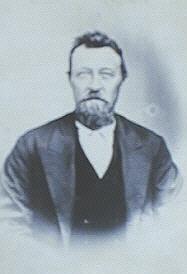 |
John
Thorpe
Layton
1831-1905
|
The Californian gold rush of 1849 was the biggest ever known and attracted thousands of prospectors who flooded in from around the world following a major find by a Swiss settler, J A Sutter. Fortunes were soon being made and lost too in the plethora of gambling houses that mushroomed, along with saloons and brothels, in San Francisco which grew from a village to a city of 25,000 in the space of a few months.
Within the United States alone, more than 80,000 people headed west and the nation's unexplored heartland was soon criss-crossed with trails. More still sailed in via Cape Horn or crossing the Panama isthmus while others arrived from Australia, China and of course Britain. Among them was John Thorpe Layton, second son of William Layton,
a local farmer and former landlord of the Bull Hotel in the Market Place at Bourne [now the Burghley Arms], who decided to leave home and seek
his fortune in the new world. He is one of the few who did and who kept it.
In July 1849, when he was only eighteen, he signed on as a seaman aboard the barque Jane Dixon that sailed from
Liverpool bound for California, sailing around Cape Horn to San Francisco, reaching there in January 1850. He left the ship there and spent the next few months engaged in boating and fishing on the Sacramento River and San Francisco Bay until the spring of 1851 when he took a passage from San Francisco and came to the mouth of the Umpqua river in Douglas County. He landed at Gardiner and made his way through southern Oregon to the mines at Yreka and Scott River, northern California, remaining in the locality until 1st August 1852. He then moved to Jackson County, Oregon, and worked in the mines around Jacksonville until 1858, thence to Williamsburg, Josephine County, where he was engaged in trading and mining with fair success. In 1877, he bought a farm and established a homestead.
He was frequently attacked by Indians but he fought them off successfully and in order to help suppress the various uprisings, he enlisted on 8th August 1853 in the company of Captain John F Miller as a private and served for thirty days. On 13th October 1855, he joined Company F, commanded by Captain A S Welton, and remained in the army until 13th November 1855. While living in Jacksonville, Layton got married on 13th February 1856 to Mary T Nail (born in Missouri in 1840) and there were five children, of whom the oldest died in infancy. The others were Charlotte, Lola, Mary and Ida. His wife Mary died on 20th December 1864.
Layton was married again on 18th August 1866 to Harriett F Doak (who was born at Illinois) and they had one child, William, but he divorced her in 1868. His third wife was Theresa Moore (born at Spencer Creek, Lane County, Oregon, 24th April 1852) whom he married on 8th November 1871 and they had nine children, Edward, Rose, Ella, Florence,
John (Lester), Lena, Cora, Jessie and Amy.
Twenty-five years after leaving Bourne, Layton had become an astute businessman and property owner. He also developed the hydraulic mining system that was used when the deposit was soft and lay under a loose overburden. This method is known as hydraulicking in which strong jets of water are projected against the bank of
gravel and overburden which are loosened and washed away by the action of the water. Beds of gold or tin bearing gravels were subsequently mined in this way.
|
ASTUTE BUSINESSMAN
John Layton, pictured in later life, a much
more mature and astute businessman and highly respected n his
profession and soon news of his progress had reached Bourne where
relatives and friends were proud of his achievements. |
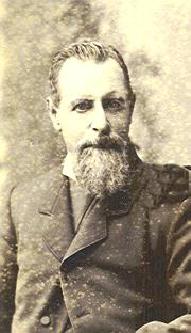 |
On Friday 31st December 1875, his progress was reported by the Stamford Mercury who had been sent a cutting from a newspaper at Jacksonville reporting on his progress. It read:
The principal operations of this place (Jacksonville) are carried on now, as heretofore, by J T Layton - the history of whose ups and downs in the way of mining experience would furnish an interesting contribution to literature. He is at present, however, generally acknowledged to be on the high road to fortune, though the result has not been attained without the exhibition of uncommon pluck, energy and perseverance, through a long and protracted career of mining. The big ditch, that broke up so many men in its construction, among others Maury and Davis, formerly of Jacksonville, is now owned and controlled principally by him, which practically renders him, so far as mining is concerned, "monarch of all he surveys". The opening of one claim alone cost him nearly $10,000. To this, he has a hydraulic attached, with over 200 feet fall, by which he is enabled to work ground that would not pay to work by hand. His last clean up amounted to about $5,000, or say $3,000 over the expenses of the run, and this is not what was considered to be the best ground. A great deal that was worked probably had nothing in it; but the expeditious manner in which the soil was made to disappear before his immense hydraulic made this drawback a scarcely noticeable consequence. He owns two other valuable mining claims in this vicinity, worked by hydraulics.
In 1904, his standing in the community was summed up in an account published in
the book Portrait and Biographical Record of Western Oregon which eulogised his life as follows:
The claims of John Thorpe Layton, upon the consideration of his fellow residents of Jackson and Josephine Counties, rest upon his more than ordinary ability as a miner and prospector. The mining camps of this part of the state have long been familiar to him and of whom it may be said he has operated with a comparatively sure hand, and while making rapid progress, has proceeded with extreme caution in his investments. Today he is the fortunate owner of the Ferris Gulch and Williamsburg mines, both placer claims that have been in active operation for more than forty years, and about thirty miles of mining ditches. He is further represented among the stable and up building enterprises of the county by the Layton Hotel at Grants Pass, erected by himself and J W Howard in 1889, and now the sole possession of Mr Layton, being one of the well patronised hostelries of this part of the county. Mr Layton also owns eight hundred acres of mineral and agricultural land.
Since becoming a citizen of this country, Mr Layton has thrown his political sympathies with the Democratic Party but has always been averse to office holding. Fraternally he is connected with Warren Lodge No 10 A F & A M, of Jacksonville. John T Layton was the owner of both the Ferris Gulch and Williamsburg mines, in active operation for more than 40 years, thirty miles of mining ditches dug by hired Chinese labourers, builder of the Grants Pass Hotel in 1889, and owner of 800 acres of mineral and agricultural land. He has led an industrious and well-directed life and has been interested in mining for nearly fifty-three years. He has established many warm friendships in the course of his coming and going in the west and is known for his generosity, his liberal mindedness, and his enthusiastic advocacy of the climate and resources of the state of
Oregon.
Layton died on 14th December 1905 aged 74 and is buried in the Jacksonville Pioneer Cemetery at Jacksonville, Oregon, where his grave has recently been restored to its original condition by his great grandson, Gene Layton of Avondale, Arizona.
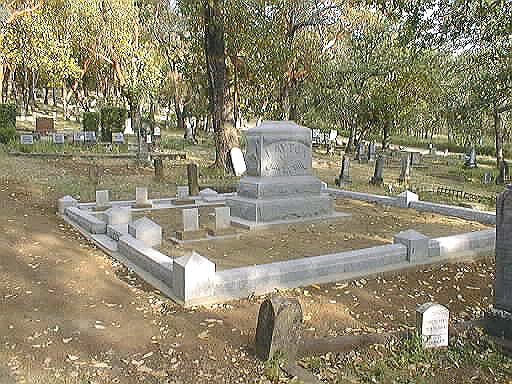
John Layton's father, William, was born on 29th January 1799, and married Mary Ann Pears (1800-1855). He was
landlord of the Bull Hotel in Bourne and is listed as such in Pigot's
Trade Directory for 1835 but by 1842, he had left the licensed trade and
become a farmer. He died in July 1872 at the age of 73 and is buried in
the town cemetery. The couple had eight children, John being born on 16th May 1831. He attended several schools in the area and then served an apprenticeship of four years at a hardware shop in
Stamford before leaving for America in 1849.
There is some evidence that he never originally intended to
remain in America but planned to return home once he had made his fortune.
This is revealed in a letter home to his father in 1855, the first he he
written since he sailed from England six years before. The Stamford
Mercury reported on Friday 22nd June 1855:
A letter was received last week by Mr William
Layton of Bourn, from his second son, John Thorp Layton, whom he had not
heard of since 1849 when he sailed from Liverpool for California. It is
dated April 15th 1855, Jackson Ville, Oregon Territory. He has been in the
mines nearly four years and intends remaining two years longer. By dint of
perseverance and hard labour, he has realised a large sum of money which
he is striving to increase before he returns to Old England. Previous to
his departure, he was serving his apprenticeship with Mr Johnson,
ironmonger, of Stamford.
On his death in 1905, he was survived only by his young sister, Charlotte, who was 15 when he left home. She spent her life as a teacher and in 1854, opened a private school in West Street, Bourne and ran it for almost fifty years, catering at first for young ladies and then for boys too. She also took an interest in the children who lived at the Bourne Union or workhouse and often took them gifts of clothing and sweets. Miss Layton retired in 1904 and made her home with Mrs G H Griffen in Harrington Street, a lady who had previously been in her employ. She took an active interest in the London City Missions, acting as the local honorary secretary and undertaking the distribution of the society's magazine in the town and was also deeply interested in the society's waifs and strays and was an energetic collector of funds on their behalf. She died on Sunday 15th October 1914 at the age of 80 and was buried in the town cemetery and although she had specifically requested no flowers, there were several floral tributes from some of the 30 past pupils of her school that still resided in the town.
|
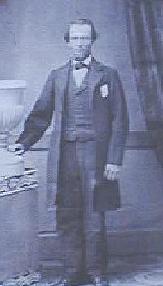 |
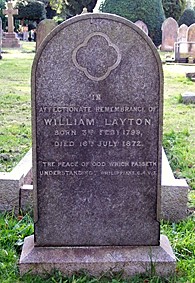 |
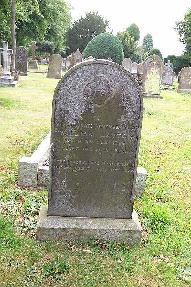 |
|
William Layton and
his tombstone in Bourne town cemetery (centre). Nearby is
that of his daughter Charlotte (right). |
NOTE: Photos
of John Layton and his grave and portrait of William Layton used
by courtesy Gene Layton, Avondale, Arizona, USA

Go to:
Main Index Villages
Index
|





